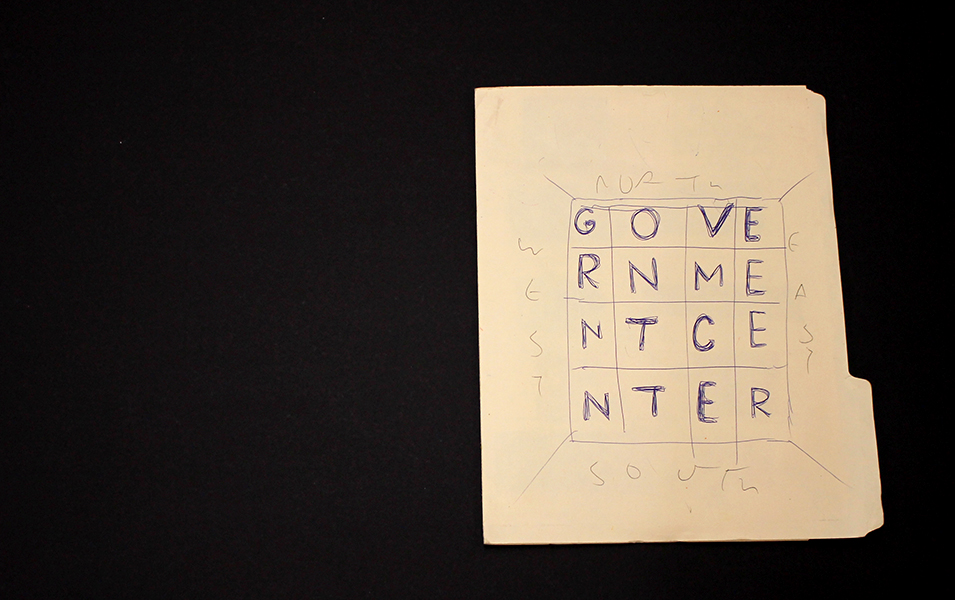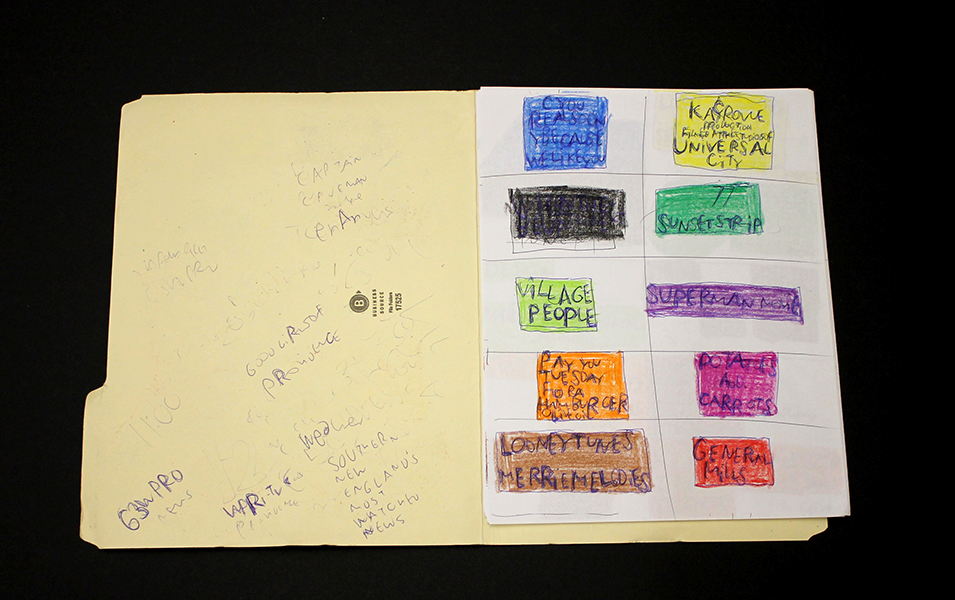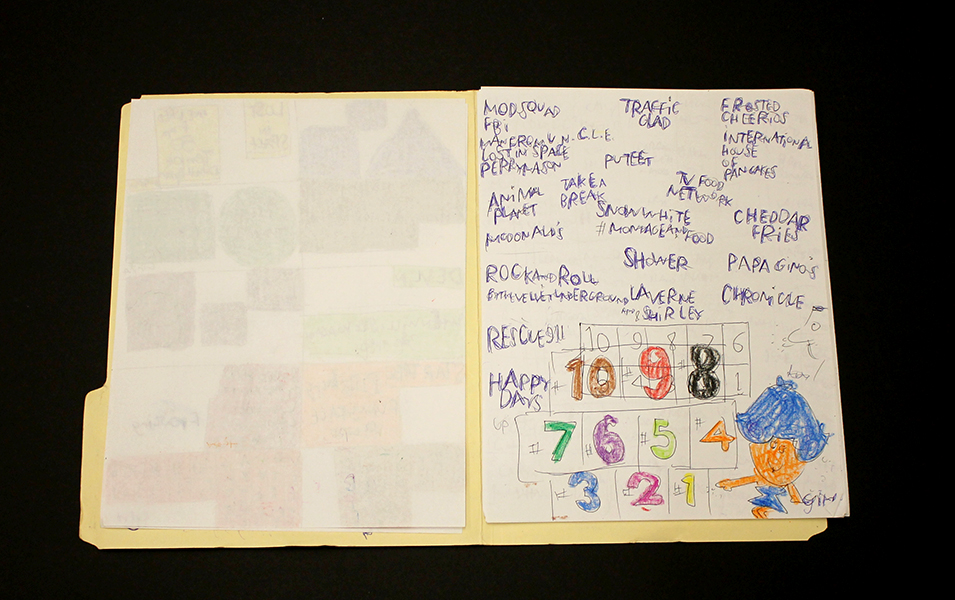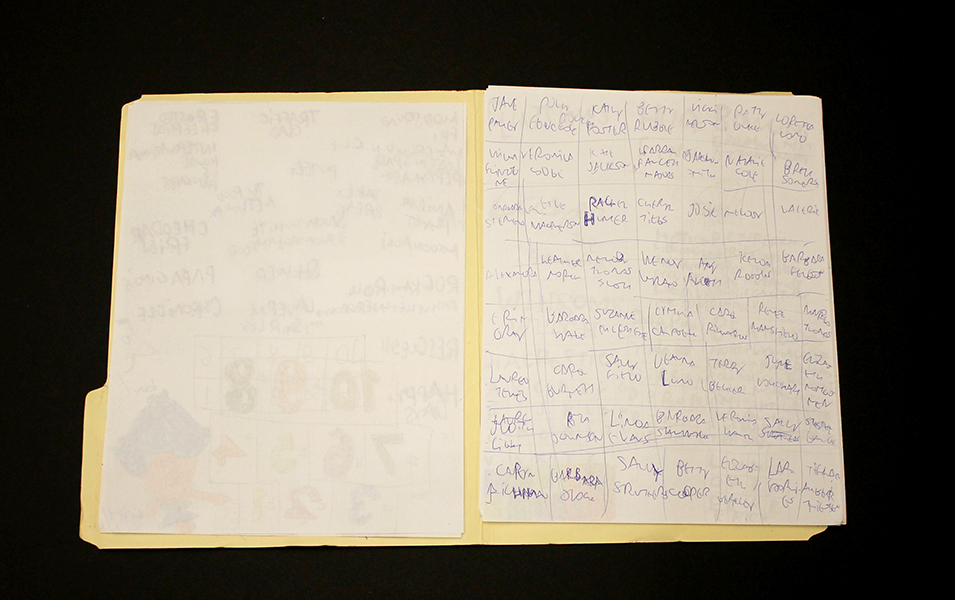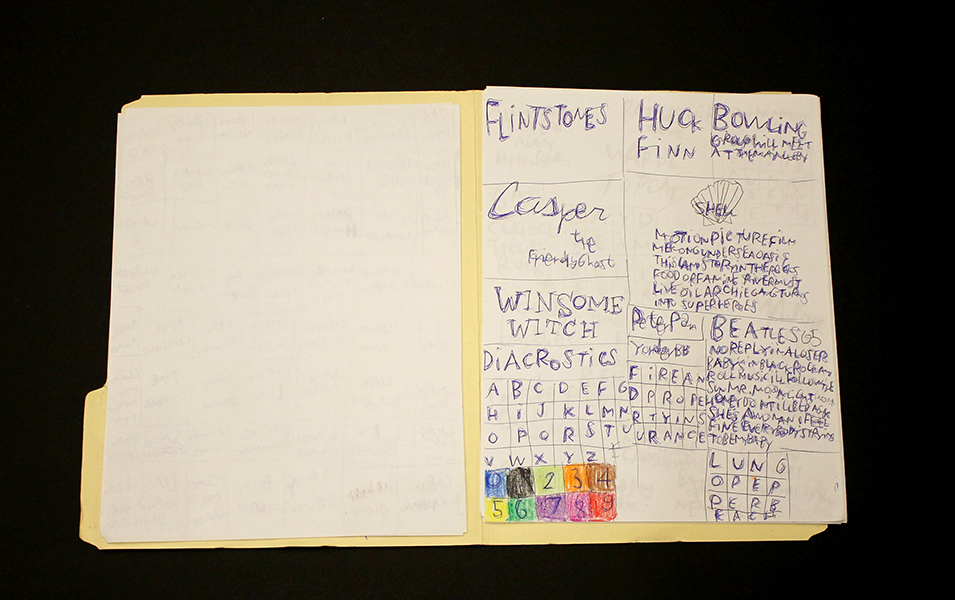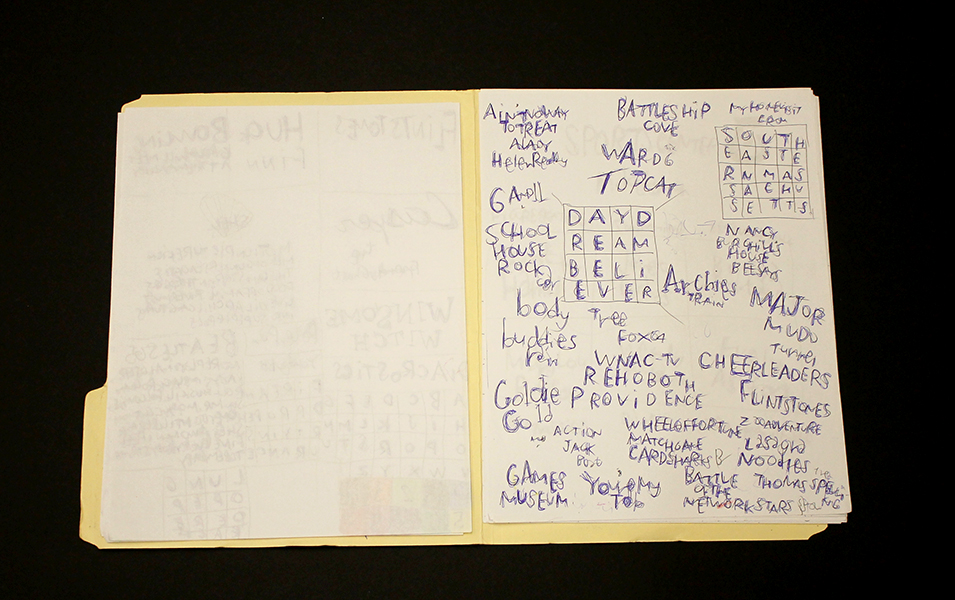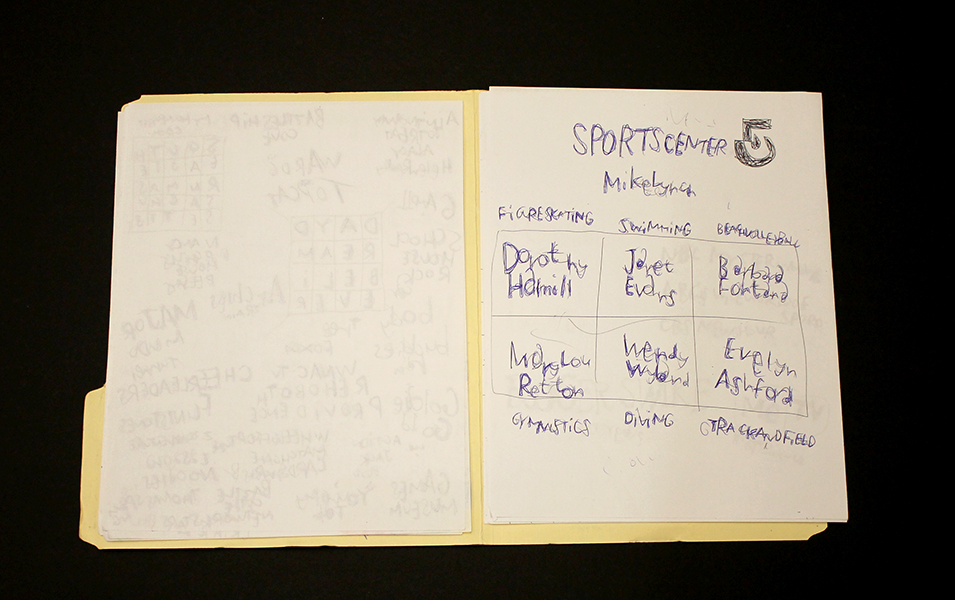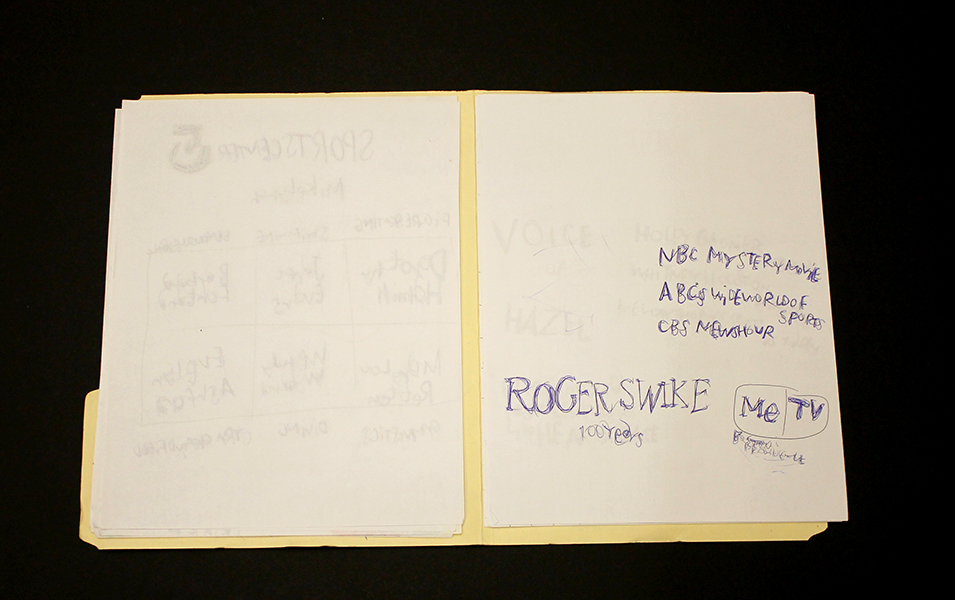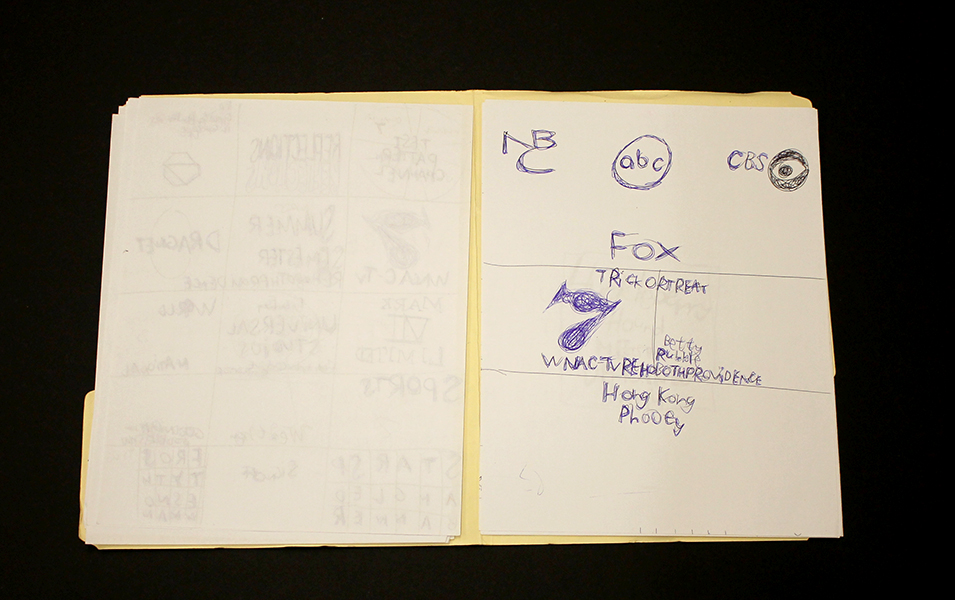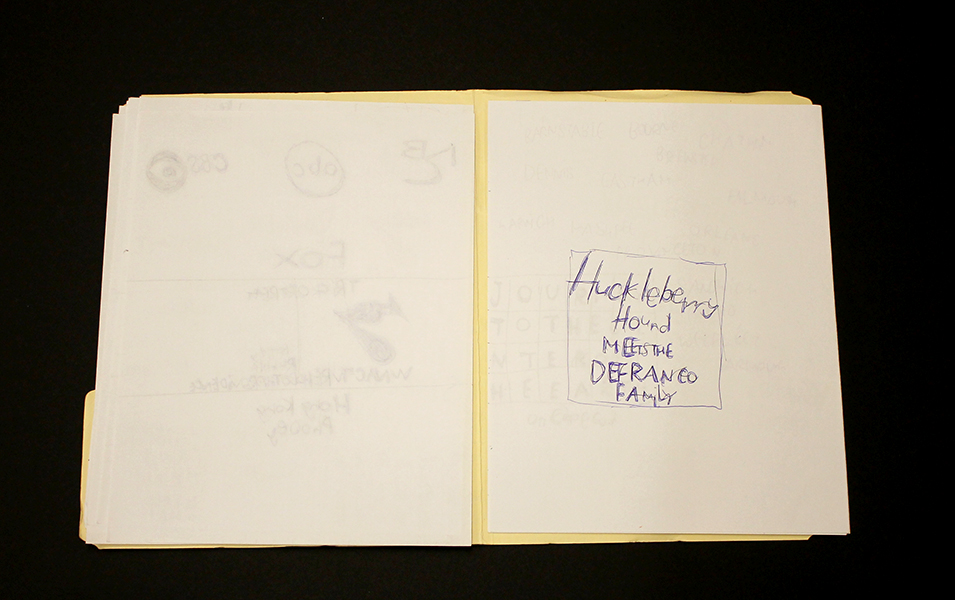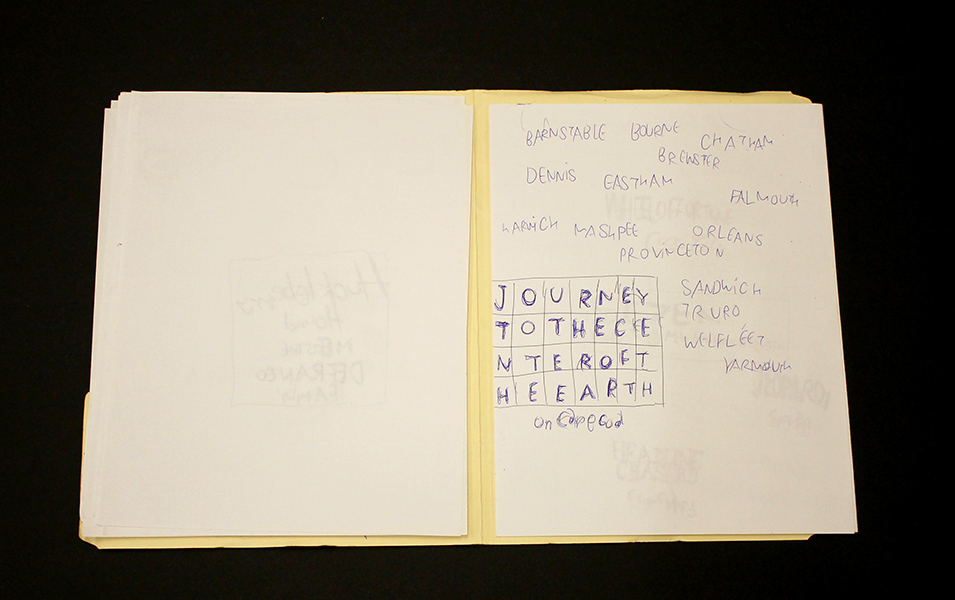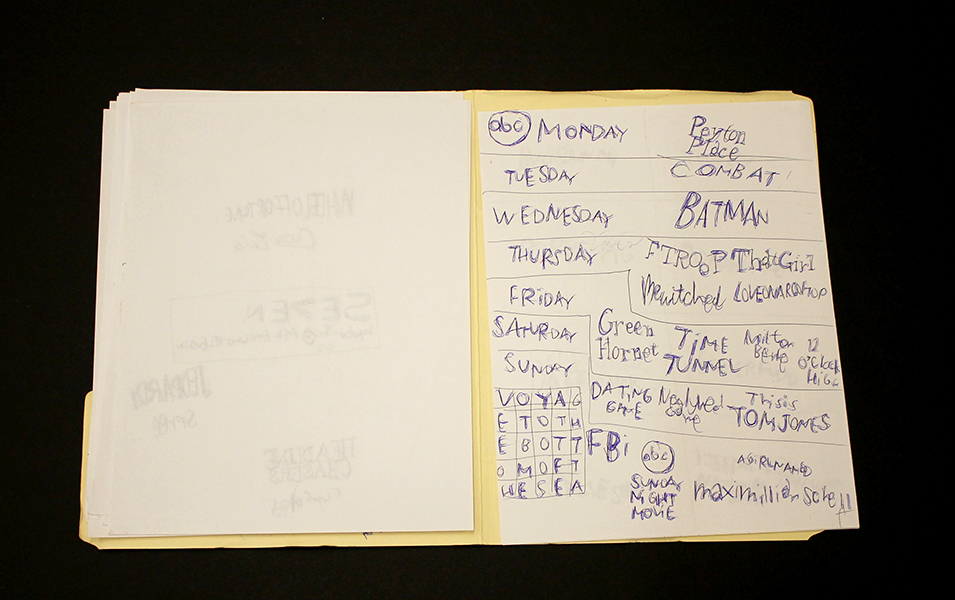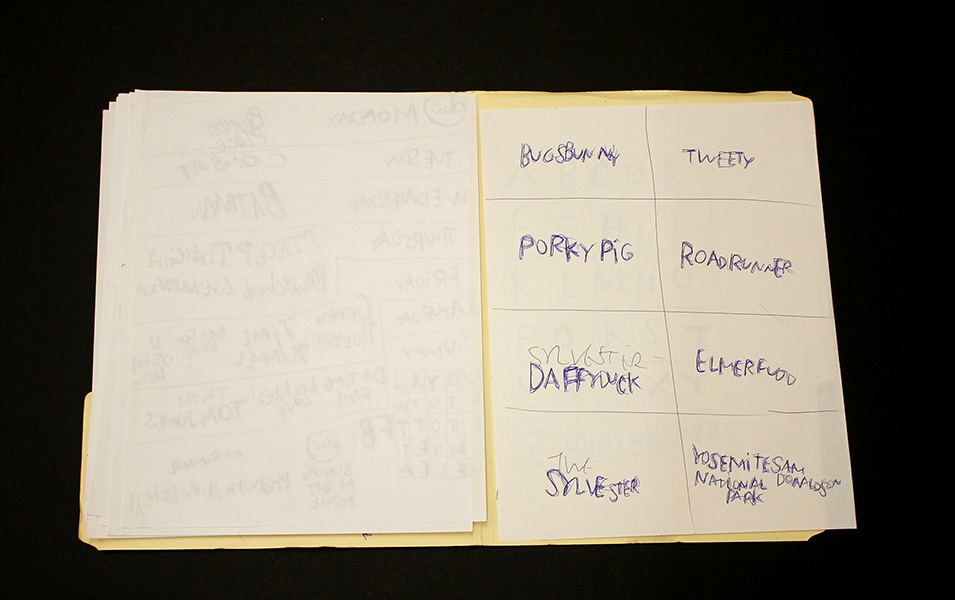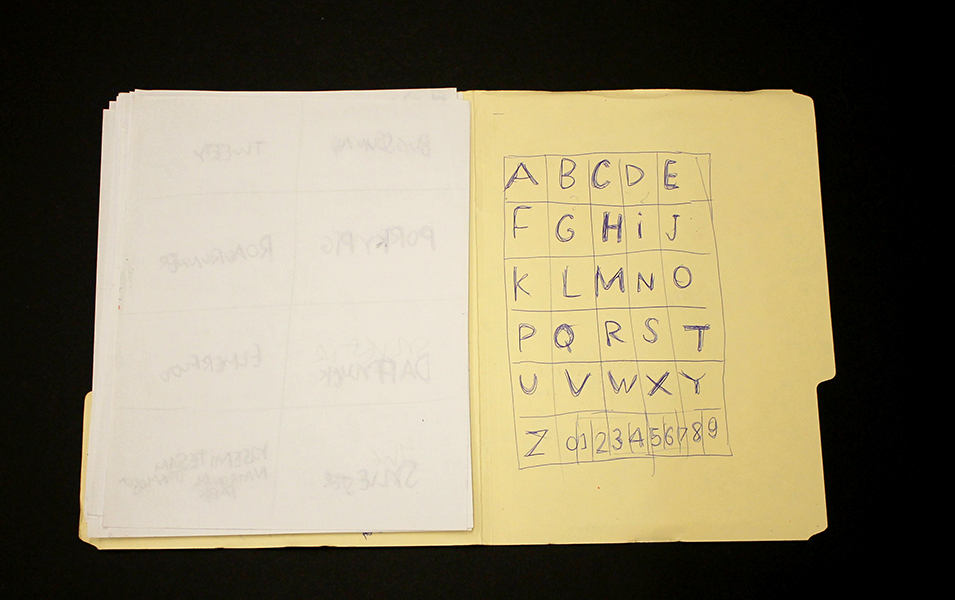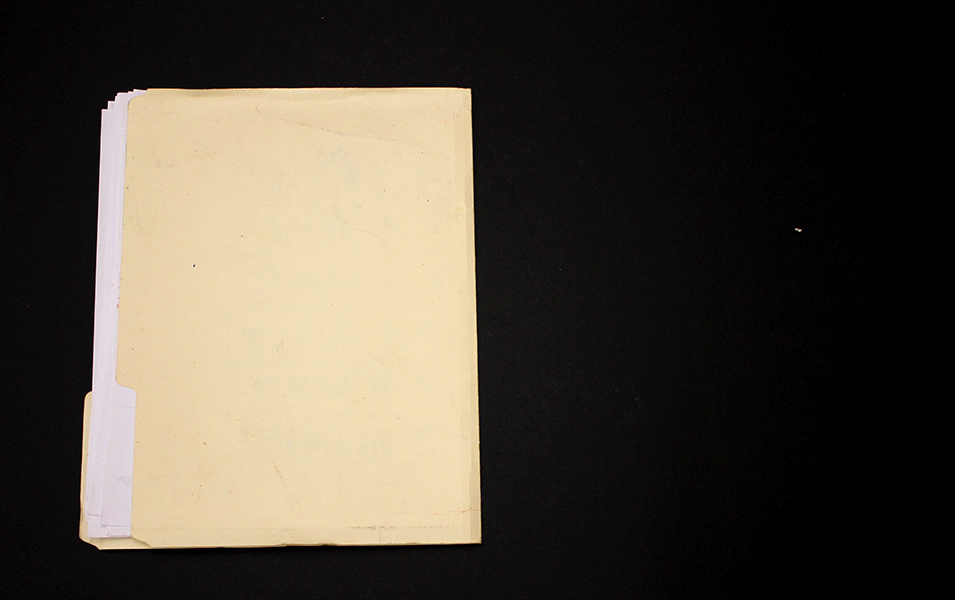This year begins with stunning solo exhibitions featuring two of this movement’s greatest contemporary artists - Helen Rae at The Good Luck Gallery in Los Angeles and Marlon Mullen at JTT in New York.
Read MoreHelen Rae at White Columns
Helen Rae, one of the progressive art studio movement's rising stars, currently has recent work on view at White Columns in NYC, marking her first east coast solo exhibition. Rae is quickly emerging as an important figure in this movement; her work is striking, wildly popular, and at 78 years old, her practice is one of great dynamism and momentum.
Read MoreEssential Fall Exhibitions
Helen Rae at KARMA, March 24, 2016, graphite and colored pencil on paper, 24" x 18"
Harald Stoffers at Cavin-Morris, Brief 163, 2010, waterproof felt tip pen on cardboard, 39.4" x 27.5"
Throughout 2016, a shift in tone and approach to presenting and discussing artists who exist outside of the traditional or mainstream (that has been crystallizing over the past few years) has continued in force. An unprecedented range of artists working in progressive art studios are being sought out by forward-thinking curators and featured in prominent galleries, including several exciting solo exhibitions - Marlon Mullen’s first solo shows at JTT and Adams and Ollman, Zinzinnati Ohio USA: The Maps of Courttney Cooper at Intuit in Chicago, and Helen Rae’s incredible second solo show at The Good Luck Gallery in LA. This trend continues and accelerates with an impressive array of current and upcoming shows that shouldn't be missed during the fall exhibition season - a great triumph for artists with developmental disabilities working in progressive art studios and other unconventional environments.
Billy White, Figures at South Willard in LA, September 2 - 16
Figures, organized by Celia Lesh, features a selection of narrative ceramic sculptures and drawings from the mysterious and magical oeuvre of NIAD’s Billy White. From Lesh’s curator statement:
Billy recurrently creates clay busts that begin as Vincent Van Gogh and morph into several different characters while retaining qualities of each previous personality – a hat, a mouth closed around a cigar, a mustache, a particularly muscular bicep. Vincent Van Gogh becomes Peter Sellers who becomes Redd Foxx who becomes Billy himself. Little Richard and Richard Pryor are married into a single body whose portrait is titled “Little Richard Pryor”. Sculptures of his father wear a hat that is WC Field’s, Yosemite Sam’s, and/or Jed Clampett’s. Identities are both specific and fluid, and exist in a sort of pantheon where the historic, celebrated, anonymous, and personal share a landscape.
Billy White at South Willard, Untitled, glazed earthenware, 7.5" x 5" x 3.5"
Outside at KARMA in Amagansett, NY, September 3 - September 25
Curated by White Columns Director Matthew Higgs, the extensive roster of great artists in Outside includes Joseph Yoakum, James Castle, Helen Rae of First Street Gallery, Marlon Mullen and Danny Thach of NIAD, William Scott, Aurie Ramirez, William Tyler, and John Hiltunen of Creative Growth, among many other contemporary artists. Participating artists (both conventionally trained and not), represent a wide spectrum of processes and media, while all investigate notions of landscape or sense of place.
Alessandra Michelangelo at Shrine in NYC, September 7 - October 9th
The first exhibition of Alessandra Michelangelo’s work in the United States (curated by Chris Byrne), is currently on view at Shrine, New York’s newest space specializing in both self-taught and contemporary art. Michelangelo’s pastel and colored pencil drawings employ contrasts in hue rather than value, which gives these abstracted figurative and architectural works a visual subtlety that softens the tone of their expressive intensity. Previous to her death in 2009, Michelangelo maintained a studio practice at Blu Cammello, an Italian progressive art studio for artists living with mental illness.
The Eloquent Place: New Works by Harald Stoffers and Josef Hofer, Cavin-Morris Gallery in NYC, September 8 - October 8th.
Featuring Harald Stoffers’ abstracted text-based drawings and Josef Hofer’s nude self-portraits, The Eloquent Place is poised to be a raw index of unspeakable vulnerability. Stoffers engages concepts similar to Dan Miller’s, but with a much more romantic tone of personal narrative; his drawings manifest as daily hand-written letters to his mother, which document his activities (both mundane and meaningful) in great detail. These two artists, well-established in the outsider art discourse, both create work in proto-progressive art studio settings in Austria and Germany.
Dan Miller, Click at Diane Rosenstein in LA, September 10 - October 16
A solo exhibition of works on paper by Creative Growth’s Dan Miller, Click includes Miller’s well-known layered text drawings and paintings, as well as selections from a lesser known body of work executed by typewriter, which are essential in understanding the true nature of Miller’s work and process. In these typed works, Miller’s hand, color, and space are reduced, revealing his message and the rhythm of his voice, which are typically obscured by his repetitive layering process while painting or drawing. This is Miller's first exhibition at Diane Rosenstein and in Los Angeles.
Dan Miller at Diane Rosenstein, Untitled, 2013, ink and acrylic on paper
Dale Jackson and Danny Thach at White Columns in NYC, September 13 - October 22
Visionaries and Voices’ Dale Jackson and NIAD’s Danny Thach both have solo shows currently on view at White Columns. These exhibitions feature a large installation of Jackson’s poetic, text-based work and a collection of Thach’s re-interpretations of Keith Haring works, which recreate the images faithfully, but are characterized by more personal and exposed paint handling. Matthew Higgs, one of the earliest champions of artists working in progressive art studios (co-curator of the seminal Create exhibition in 2012 with Lawrence Rinder and early supporter of Creative Growth’s William Scott) has continued to support Bay Area studios while also seeking out artists at Gateway Arts, Visionaries and Voices, and other small studios in the Northeast.
Charles Steffen at The Good Luck Gallery in LA, September 3 - October 29
This marks the first exhibition of Charles Steffen’s work in Los Angeles, in cooperation with Andrew Edlin Gallery. Steffen’s graphite and colored pencil drawings on found paper “resemble pages from an idiosyncratic self-referential field guide with sunflowers, crucifixions and figures complemented by scrawled diaristic ruminations. The figures are often transparent, as if their nerve cells and fibers were on display, and surrounded by aureoles of gray light; bodies and flowers often merge into each other.” Steffen originally began a prolific drawing practice during a fifteen year stay at the Elgin State Hospital in Illinois, which continued until his death in 1995.
Susan Te Kahurangi King: Drawings 1975 - 1989 at Andrew Edlin Gallery in NYC, September 16 - October 30
The gallery’s second exhibition of New Zealand-based artist Susan Te Kahurangi King, curated by Chris Byrne and Robert Heald, is highly anticipated and runs concurrently with her first solo museum show at the ICA Miami. Byrne’s 2014 exhibition of King's work, Drawings from Many Worlds, was widely revered as one of the best exhibitions that year. Known for her colorful, frenetic abstractions of invented characters and appropriated Disney icons that predate Arturo Herrera, Drawings 1975-1989 features a lesser known, primarily monochromatic series of pattern-based drawings in graphite. While more minimal and understated than King's previous work, they remain highly original and compelling.
Courttney Cooper at Western Exhibitions in Chicago, November 12 - December 31
Visionaries and Voices’ Courttney Cooper has a well-deserved first solo exhibition with Western Exhibitions, one of Chicago’s best contemporary art spaces. Cooper's complex bic pen drawings document his intimate experience with Cincinnati, accumulating across increasingly massive surfaces (created by gluing together scrap paper that he gathers while working at Kroger). Cooper creates an authentic network of specific places and structures; his streets are intensely composed of details from memory or observation, cataloging expressions of particular moments or time of year. The relationship of these moments to each other in space is approximated, as in memory - all of which culminates in a dizzying realm of overlapping information that becomes a living record, adorned generously with nostalgic, commemorative expressions of community and identity.
Mapping Fictions at The Good Luck Gallery
We recently had the honor of guest curating an exhibition at The Good Luck Gallery, an important, new space in Los Angeles. Founded and directed by former Artillery publisher Paige Wery, The Good Luck Gallery is the only space in LA dedicated to showing the work of self-taught artists. Wery fosters the burgeoning careers of artists such as Helen Rae and Deveron Richard, who maintain studio practices in progressive art studios, as well as artists like Willard Hill, who fall into the Outsider, Visionary, or Vernacular categories. Mapping Fictions, curated by Andreana Donahue and Tim Ortiz, opened on July 9th and will be on view through August 27th.
Read MoreMapping Fictions: William Scott
Inner Limits to the Future of Hollywood of the Real Science Fiction Movies, acrylic on canvas, 48" x 54", 2013
The Twilight Zone, acrylic on canvas, 36" x 48", 2014
Inner Limits Will Exist in 2017 of a Real People of New Science Fiction, acrylic on paper, 25" x 33"
San Francisco-based artist William Scott is a believer in a better society, a self-described “peacemaker” and “architect”. His works are the celebratory announcement of the wholesome future; they not only imagine an alternate universe reflecting his personal aspirations, but proclaim with joyous conviction his utopian vision of San Francisco, “Praise Frisco”. Scott’s paintings, drawings, and sculptures are executed in an aesthetic consistent with this gospel of idealism and excellence, shining with a pristine vibrance.
William Scott’s paintings of cityscapes and beaming figures surrounded by bold text are well known and widely collected; Mapping Fictions will also include lesser known works that delve into specific plans for Praise Frisco that demonstrate surprising depth and scope, beyond just a notion of that place. In these works, Scott strives to pull the world he sees into reality by imagining its common details. Optimistic plans for ordinary architecture, floor plans of “Disneywood” condos, and development company logos all express directly that this could actually exist with an earnestness reflected in a letter to the Mayor Gavin Newsom, calling for or announcing the news of Praise Frisco.
Scott’s work can be understood in the context of the intent and ideals of Theaster Gates or Bertrand Goldberg, who have employed the traditional agency of art-making to guide communities in inventing better versions of themselves.
Like Goldberg, Scott’s architectural drawings and models recall the spare, utilitarian designs for community housing as envisioned by the Bauhaus, an idealistic solution for social progression. Goldberg “was more than an architect - he was also a philosopher. In his utopian worldview, architecture had the power to create democratic communities by serving people from all levels of society while remaining sensitive to the needs of individuals. Architects were not just capable of bringing about a better future for everyone, they were morally obligated to do so.” (source)
Disneywood in Hunters Point Areas in San Francisco for the Redevelopment Agency, marker and ink on paper, 8.5" x 11" 2006
Hunters Point Hills in 2040s for New Developments, marker and ink on paper, 18" x 24", 2007
Theaster Gates’ creative practice extends beyond his studio as social activism, urban planning, and the ethical redevelopment of distressed properties, which manifests as an immediate, tangible influence that Scott’s work does not. There proves to be commonality, however, in the ambition to activate change and critically engage the public through art. Both Scott and Gates are driven to preserve and resurrect values from the past and a sense of community that has been lost. Gates explains:
The reimagining is a means to an end, and sometimes it is its own end. There are wasted opportunities that are waiting to be beautiful again, and I'm giving them a charge. It's not so much that the buildings on Chicago's South and West sides are vacant, but that they started to lose value for the black community. These buildings had so much soul, but we imagined that, because of the violence and the schools, we should be somewhere else. So these buildings lost their soulfulness. I'm interested in showing there is still so much latent power in these buildings, and by simply making these spaces available again, and open again, great things can happen. (source)
Whether an intentional fiction, genuine aspiration, or prophecy, Scott’s elaborate narrative is a creative vehicle for social commentary, as well as a context for an impassioned and highly personal expression of his commitment to recurring concepts of humanity, spirituality, identity, and community.
William Scott’s work is included in the upcoming exhibition Mapping Fictions, curated by Disparate Minds founders Tim Ortiz and Andreana Donahue, July 9 - August 27 at The Good Luck Gallery in LA. Scott (b. 1964) maintains a studio practice at Creative Growth in Oakland, California. Scott is widely collected and has work in the permanent collections of the MOMA and The Studio Museum in Harlem. He has exhibited previously in solo exhibitions at White Columns and group exhibitions at Park Life Gallery (San Francisco), Gavin Brown’s Enterprise and the Outsider Art Fair (NYC), Hayward Gallery (London), Yerba Buena Center for the Arts (San Francisco), the Armory Show (NYC), Palais de Tokyo (Paris), and NADA (Art Basel, Miami).
Change to Mayor Edwin Lee, Ink on paper, 8.5" x 11", 2003
Mapping Fictions: Roger Swike
Untitled, ballpoint pen on paper, 12 x 9 inches
Untitled, ballpoint pen and crayon on paper, 12 x 9 inches
Untitled, ballpoint pen and crayon on paper, circa 2013 12 x 9 inches
Roger Swike's ten crayons
Roger Swike is an exceptionally prolific artist who works rapidly on many pieces simultaneously; much like Melvin Way, his drawing process channels an immediate and intuitive stream of information, yet is also executed with deliberation and great intention. Swike will often revisit drawings created at different times and deliberately organize them into various color-coded folders; the resulting works are an assertive, endearing proposition about what an art object can be. Within content that initially appears chaotic or arbitrary, familiar text referring to pop culture and the exterior world is pervasive. Black and blue ballpoint pens and ten crayons are utilized as though each tool has a symbolic role. Some ideas are organized neatly into grids, others are written in less regimented clusters or lists, primarily in multiple layers of ballpoint pen. Over time, curious relationships and subtle patterns emerge, such as references to the number 7 or numbers listed on their own counting down from ten (but when listed alongside the alphabet they ascend from 0 to 9).
Because Swike’s work is disciplined and systematic, the viewer is tempted to decipher the rigid system that defines it, but the true nature of the work seems to reside in the plasticity of its rules. A grid listing Loony Toons characters deviates from the pattern to include "YOSEMITE NATIONAL PARK SAM DONALDSON", numbers are written in black ballpoint pen without an overlapping of blue pen, words or phrases are redacted, yet the sequence and grid are still drawn using the ten selected colors…often it feels as though Swike isn't creating the system, but instead exploring it as a poet does language, both fluent and curious. Each time Swike's lexicon is revisited, it presents an opportunity to rethink its mysterious nature - possibly an archive, message, map, poem, or something else entirely.
Roger Swike’s work will be included in Mapping Fictions, a group exhibition curated by Disparate Minds writers Tim Ortiz and Andreana Donahue at the Good Luck Gallery in LA, July 9 - August 27. Swike (born in Boston, 1962) has shown previously at the Berenberg Gallery in Boston, Fuller Craft Museum, the Outsider Art Fair, Margaret Bodell Gallery, and Phoenix Gallery in New York. He has also been awarded a MENCAP award in London, England.
We first encountered Roger Swike’s work many years ago, as studio co-managers and facilitators in a progressive art studio in Nevada; we began visiting other studios while traveling (before the inception of Disparate Minds). Swike has maintained a studio practice at Gateway in Brookline, Massachusetts (the oldest progressive art studio in the US) since 1995. Despite this, his extensive body of work remains relatively unknown outside of the Boston area, possibly because the art world hasn’t quite been ready for work as contemporary and singular coming from a living, so-called outsider artist.
Mapping Fictions: Joe Zaldivar
West Club Entrance at NRG Stadium, graphite, micron, and marker on paper, 18" x 24", 2016
Street Map of City of Industry, California, graphite, micron, and marker on paper, 18" x 24",
Gates 5-8 of Sports Authority Field at Mile High, graphite, micron, and marker on paper, 18" x 24", 2016
Joe Zaldivar’s work documents and reimagines disposable or forgotten media with permanence and idealism; his vast and varied oeuvre includes massive, detailed hand-drawn maps, intricate interiors and landscapes drawn from Google Street View imagery, and drawings referencing local business mailers, logos, advertisements, and tv stills. He has also compiled an enormous, ever-expanding archive of home-recorded video ephemera which is uploaded to a YouTube channel (including cold opens, sign-ons/sign-offs, and advertisement segments from obscure tv broadcasts dating back many years), all citing sources, dates, and times.
To parse the intent or underlying conceptual framework of Zaldivar’s intensely elaborate creative endeavor, his Street View landscapes and interiors provide an important entry point. As a whole, they feel like the collected documents of a digital explorer searching for and preserving scenes from around the world, often capturing iconic landmarks: sports stadiums, restaurants, famous storefronts, etc. Aesthetically, each of these drawings isolates a moment (a necessary quality of any still image), a tendency that’s especially engaged in his drawings, as in Cindy Sherman’s film stills. This sense of candid immediacy and stillness could be attributed to the automated eye of the google maps camera car; Joe's interpretations of these moments, however, are more nuanced and often altered.
The Coffee Roaster, 13567 Ventura Boulevard, Sherman Oaks, California, graphite, micron, and marker on paper, 18” x 24", 2016
The Coffee Roaster, for example, remains faithful to its source material except for a few deviations; the billboard has been replaced with one lifted from another image, and one of the patrons (whose face is blurred in the street view image), is replaced with a man loosely resembling Homer Simpson, both of which are references to a 1995 episode of the Simpsons (Treehouse of Horror VI). In this episode, Homer Simpson ends up at “Erotic Cakes”, a bakery in the real world via interdimensional travel, the actual filming location being the storefront of The Coffee Roasters. This drawing exemplifies the manner in which Zaldivar’s work traverses multiple layers of meaning - navigating the world, drawing connections between reality and fiction, and isolating or describing fully a specific moment.
Recorded during the USA Christmas movie special, a 1973 20th Century Fox Television remake of the movie "Miracle on 34th Street" starring Jane Alexander, David Hartman and Sebastian Cabot on Tuesday, December 19, 1989 on USA Network.
In this context, recording moments digitally and creating intuitive, thought-provoking connections across various media, Zaldivar’s YouTube channel is a compelling enigma. Zaldivar's channel isn’t the only one of its kind, this curious practice has a surprising cult following. He’s among the most popular, however, with almost 2000 subscribers and nearly 4 million total views of well over 1000 videos. Sometimes he records directly from recent broadcast television, while other segments are culled from VHS tapes found at yard sales. Whereas other channels featuring this kind of content are direct digital transfers from other media, Joe records his television screen by hand with a tablet computer - the filter of his gaze is always present. Much like his Street View drawings, these recordings are slightly unsteady, but intensely diligent. As extensive as his archive is though, the moments he chooses to document are just a few waypoints into the realm of ephemeral television media. There’s a distinct ambition across all of his works to address and highlight moments not originally intended to be the focus of the media that they reference (as evidenced particularly in this early work).
Zaldivar with a work in progress, from a recent studio visit at First Street Gallery Art Center
Chicago Area Vicinity Map, graphite, micron, and marker on paper, 90" x 48"
Given the map-like quality of Zaldivar’s process, it’s intuitive that his body of work would include actual maps. Zaldivar creates large-scale maps in 18” x 24” sections (usually divided into a grid of 8 or 10); he diligently works on one section at a time while referring to an iPad, with the completed sections stacked neatly beneath the one in progress. These hand-drawn cities reclaim selections from that endless modern world of digital maps, generated by swarms of satellites and computer systems, as a personal and human experience. Through this lens, his smaller drawings that incorporate both road maps and disposable ad imagery (logos, slogans, place names) can be understood as signifiers for a specific time and place.
Joe Zaldivar (b. 1990) attends First Street Gallery Art Center in Claremont, California (the same studio that supports the great Helen Rae). He has shown previously in Wunderkammer, an invitational group exhibition at Pitzer College's Nichols Gallery and Street Views, a solo exhibition at First Street Gallery Art Center. Zaldivar was the initial inspiration for the upcoming group exhibition Mapping Fictions: Daniel Green, William Scott, Roger Swike, and Joe Zaldivar at The Good Luck Gallery in LA, curated by Disparate Minds writers Tim Ortiz and Andreana Donahue, which will be on view July 9 - August 27, 2016.
Deveron Richard
Sectra Shower, watercolor on paper, 18" x 24”, 2014
The Milkets, watercolor on paper, 26" x 32”, 2015
The Planets, watercolor on paper, 17.25" x 23.5”, 2009
A Border Between Unicorns, watercolor on paper, 19" x 25.5”, 1996
Deveron Richard maintains a creative practice at one of many ECF art centers in the LA area (previously discussed by Disparate Minds in terms of their relationship to DAC Gallery). His inaugural solo show is currently on view in LA at the Good Luck Gallery through May 21st. From the Good Luck Gallery:
“An idiosyncratic iconography of visionary space travel and anthropomorphic sexuality arrives via the South Bay of Los Angeles through the singularly fertile imagination of Deveron Richard. Winged horses in brassieres and high heels glide peacefully around the cloud-enshrouded towers of a futuristic city, polar bears in lipstick and slit dresses prance through a fluorescent arctic landscape, and provocatively-attired unicorns face off on a hallucinatory geometric color grid. These hybrid creatures of exaggerated femininity exude a quirky eroticism. Rendered in watercolor with a distinctively saturated palette, inventive draftsmanship and hypnotic backdrops of complex rhythmic patterning. Other works depict interplanetary battles with rockets hurtling through galaxies and deadly beams shooting into space.”
Masters and Emerging Artists at the Outsider Art Fair
Art Project Australia’s Julian Martin at Fleisher/Ollman
At the 24th annual Outsider Art Fair in New York, it was clear that there has been a profound shift. Superficially, the aesthetics are far from the folk art antique shop feel of the past, having assimilated to a presentation more typical of the mainstream - a change generally attributed to one of field’s most successful champions and current fair organizer, Andrew Edlin. On a deeper level, the definition of “outsider” is flexed to a degree that's able to contain a broad spectrum of idiosyncratic works - from the visionary scarecrows of the late Memphis-based artist Hawkins Bolden, to Marlon Mullen’s lush abstractions, to an installation of 3D printed sculptures designed by 65 unconnected collaborators (presented as the work of a manufacturing company, Babel curated by Leah Gordon). Abandoning category without losing identity, the context of this forum has evolved rapidly over the past few years.
In a review of the fair for Design Observer, John Foster recalls that at the inception of the genre, early outsider art dealer Sidney Janis introduced the concept that “serious art could be made by everyday people”, a notion that's difficult to sympathize with today (if artists aren't “everyday people” then what are they?). This train of thought still seems to have some novelty for some 74 years later, as illustrated by Barbara Hoffman’s odd New York Post headline “The artists at this amazing fair are prisoners, janitors, and mental patients”. Ultimately, Edlin has allowed the fair to begin to merge seamlessly with the mainstream by expanding to include a flexible set of principles rather than depending on this particular kind of romantic narrative structure. It’s no longer necessary that the artists work in isolation or live obscure, misunderstood lives.
Rather, it’s a space for excellent creative endeavors that are genuine and created for their own sake, or for a context not ordinarily included in the art world. The most essential principle underlying this movement is that the institution of the market isn’t what engenders great work. In a climate where Laura Poitras (a filmmaker and journalist with no prior fine art experience) has a significant exhibition opening today at the Whitney, the particular terms and intent with which the OAF brings divergent, highly original perspectives to the art world maintains a distinct and important purpose.
The beauty of this more elastic definition is its efficacy both presently and retroactively, indicating that this isn’t so much a shift in paradigm as a greater understanding of why these works have been so compelling all along.
Hawkins Bolden at Shrine
As usual, titans of the self-taught canon were featured extensively throughout the fair: Henry Darger, Joseph Yoakum, Adolf Wolfli, Jesse Howard, Bill Traylor, Thornton Dial, Minnie Evans, Martin Ramirez, Gayleen Aiken, Frank Jones, Royal Robertson, and James Castle, etc. These masters (the ones who have inspired so many to work in this field) continue to be represented by fantastic works, not due to a traditional romantic narrative, but because of genuine, sophisticated, and highly original visions, as evidenced by their conceptual harmony with work by contemporary “outsiders”.
The fair's strongest and most relevant exhibitions, however, were contemporary works by artists who maintain studio practices at progressive art studios - a dynamic collection of installations that were, in sum, a tour de force eliminating any question about their importance to this emerging sub-market, and potential to sustain, develop, and gain momentum.
Marlon Mullen at JTT/Adams and Ollman
Marlon Mullen, NEWS (P0329), acrylic on canvas, 24" x 36"
The fair’s most important moment, and starkest example of the flexed "outsider" categorization, was the joint exhibition of NIAD’s Marlon Mullen by New York’s JTT Gallery and Portland’s Adams and Ollman - a solo exhibition of reductive acrylic paintings, with content explicitly referencing the contemporary mainstream. The narrative justification for its inclusion would be the assumption that these abstractions are defined by an unusual way of thinking and seeing, as opposed to a neurotypical artist’s contrived deconstruction of found imagery. Whether Mullen is engaging in abstraction in the traditional sense, creating representationally from his own perspective, or whether there is no meaningful difference between representation and abstraction in his experience is impossible to determine. Ultimately, their genesis becomes irrelevant because the elusive power of the imagery is an amalgamation of the inherently expressive nature of the work's formal elements, which isn’t dependent on a mutually understood way of seeing. The real triumph and importance of Mullen’s work lies in the revelation that their mysterious conceptual origin only causes their success to be more fascinating, and that they’re pushed to a degree of technical sophistication that’s unmistakably impactful. His paintings are paradoxically thoughtful and casual, as awkward as they are bold, as messy as they are delicate. These pieces embody a deeply genuine and intuitive quality that coexists with a strength defined by specificity and fine tuning.
Helen Rae at The Good Luck Gallery
Helen Rae, July 1, 2015, colored pencil and graphite on paper, 24" x 18"
The fair’s most generous moment was The Good Luck Gallery’s installation of stunning Helen Rae drawings - surfaces saturated with vigorous mark-making culminate in robust, stylized worlds rendered in graphite and colored pencil. Rae’s counter-intuitive re-imagining of the boundaries between abstraction and representation are thrillingly confounding. Strong graphic or patterned passages have an inexplicable sense of depth and form, which transition into fields scattered with spare details, achieving an almost photographic quality - all of which emerges from a surface that (when examined closely) possesses a roughly inscribed physicality. The continuous stream of excellent new drawings replacing sold work served as a testament to the promise of this prolific septuagenarian as an emerging phenomenon to watch.
Andrew Hostick at Morgan Lehman
Photos do little to capture the true nature of Andrew Hostick's drawings at Morgan Lehman Gallery. Not evident above is the experience of approaching this simple red, blue, and brown figure eight to discover that it’s surrounded by an opaque, shimmering field of marks in white colored pencil, worked hard into the mat board surface. The mystery of choosing to color a white surface white, is in its own way explained and not compounded by its eventual effect: fantastic moments of wonder in a distinct and familiar space. The curious effect of this subtlety achieved in such a laborious manner lays a foundation for the elusive mood that runs throughout all of Hostick’s works. He seems to search for, and with great success, achieve abstractions that aren’t just poignant in a general sense, but evoke a beautifully bleak, arid quality that seems to romantically belong to Ohio.
Andrew Hostick, Leon Polk Smith: A Constellation with Works on Paper, graphite/colored pencil on mat board,
Kenya Hanley, Family Matters, 2015, Mixed Media on Paper, 17" x 14", image courtesy Land Gallery
Other highlights included the velvety pastel abstractions of Art Project Australia’s Julian Martin at Philadelphia’s Fleisher/Ollman, humorous, pop-culture driven drawings by Kenya Hanley and Michael Pellew at LAND Gallery, Harald Stoffers at Cavin Morris Gallery, Joe Minter and Lonnie Holley at James Fuentes, Evelyn Reyes, Daniel Green, and Camille Halvoet at Creativity Explored, Terri Bowden, Susan Janow, and William Scott at Creative Growth, Walter Mika and Victor Critescu at Pure Vision, and an impressive quantity of work by artists at Japanese studios. Although only 4 progressive art studios exhibited independently at this year’s fair, their respective artists were prominently featured in a quarter of the exhibitions, including those of the most prominent dealers.
Henry Darger and Judith Scott at Andrew Edlin
Susan Janow, Untitled, colored pencil and micron on paper
Harald Stoffers, Brief 164, March 10th, 2012, ink on paper, 39.25" x 27.5", image courtesy Cavin Morris Gallery
Lonnie Holley at James Fuentes, NY
One of the most important insights from this year's Outsider Art Fair is that the progressive art studio can no longer strive to position itself as a neutral, invisible player between self-taught artists and an outsider art gallery. Undeniably, progressive art studios are poised to be a truly important movement, but, reflecting on this changing landscape it’s important that they critically evaluate their role in presenting work to the market. Despite their prevalence at the fair, gallerists had no reservations about expressing that they’ve been forced to stop representing artists they believe in due to studios' failures, ranging from unethical behavior (such as gifting works to program board members) to providing intrusive facilitation to simply being disorganized. The process of translation from outsider to the mainstream fine art market is delicate, and is something outsider art dealers are just now learning to do effectively; they’ve been an asset to studios because of their willingness to represent unique artists without ties to the broader art community. As the distinction continues to break down between outsider and insider, however, studios can only continue to be relevant if they’re able to proactively take on the responsibilities of translation and promotion typically provided by gallerists (including handling and documenting artwork properly).
The future of this process is pioneered right now by career paths that resemble the ones profiled above: NIAD, JTT, Adams and Ollman, and Marlon Mullen; Visionaries + Voices, Andrew Hostick, and Morgan Lehman; First Street, Helen Rae, and Good Luck Gallery; and Creative Growth, William Scott, and White Columns. Progressive art studios must believe in and champion each of their great artists with respect for their individual vision, with a focus on developing careers that extend beyond their program of origin.
Mark Hogencamp, Untitled (IMG_2616), Digital C-print, 27" x 36", 2014
In the traditional narrative of outsider art, the career of an artist such as Mark Hogencamp would have ended with the initial discovery of Marwencol. Ideally in the past, he would have been deceased before the work was found and his fixed oeuvre would be intrinsically associated with the story of a strange man working in isolation and obscurity (much like Darger and Ramirez). Mark Hogancamp, however, is no longer obscure or working in isolation. His new work at this year's fair, scenes created using full-sized mannequins, are a clear and exciting new development in his creative process. Hogancamp’s work is not at all diminished by the open involvement of his facilitator and gallery director Eddie Mullins, who we spoke with at One Mile Gallery’s booth. In our conversation with Mullins, his relationship with Hogencamp was remarkably familiar. Marwencol is a project absolutely devised and driven by Hogencamp, but Mullins has no inhibitions about explaining that the use of mannequins began after he provided some for Mark. Mullins plays an instrumental role in how Hogencamp’s vision is ultimately seen as art, but his assistance isn’t mistaken for collaboration (much like the relationships sound engineers and producers have with musicians). In this way, the transparency of this relationship sets an important example for studios to follow.
Recognizing the true nature of the facilitated creative process, including that provided by artist staff in the studio, must be fully open to criticism in order to progress; it’s simply too personal, dynamic, and delicate to be left out of the discussion. The next wave of great artists will come out of progressive art studios that are not only assisting artists to initiate a creative practice, but also provide innovative and ambitious new facilitation methods to further develop dynamic bodies of work.
Helen Rae
Untitled, colored pencil/graphite, 26" x 20”
Recent Drawings, at The Good Luck Gallery in LA, is a beautiful collection of colored pencil and graphite works on paper by Helen Rae. These drawings live in a space between the realms of representation and abstraction, most often realized as figures surrounded by ambiguous, pattern-driven environments resembling textiles or foliage.
Untitled, colored pencil/graphite, 26" x 20”
Rae’s incredible abstractions aren’t merely expressive, stylized reimaginings of found photos and magazines; each drawing seems to engage and elevate its source image with drive and ambition. Rae seems to search through the image, read it like a rich text, and celebrate every passage - the shadow of a frame against the wall, heel of a shoe, zipper on the side of a bag, are all described with incredible detail and conviction. Inevitably, the figures and faces remain expressive and bold, even as they’re nearly lost in a cacophonous ecstasy of patterns.
Lucien Freud said that “...truth has an element of revelation about it. If something is true, it does more than strike one as merely being so...” In exactly this sense, Rae’s works are undeniable revelations. The impact of the clean, uniform installation is vibrant and specific, further emphasizing the singularity of each drawing.
Much like LA-based artist Eric Yahnker, Rae explores the limits of the often overlooked and rarely mastered medium of colored pencil. These achievements are the direct result of engaging in an uncommonly committed creative practice. Rae has been a studio member of First Street Gallery Art Center since it’s founding in 1990 - First Street’s Seth Pringle asserts, “Helen's focus and dedication in the studio are unmatched. She rarely misses a day and when she's in the studio she's always working diligently. The style and execution of her drawings have slowly but steadily evolved over the course of her 25 year career, growing in compositional complexity to its current state of mind-boggling beauty and intensity.”
The Good Luck Gallery is currently the only commercial exhibition space in Los Angeles devoted to self-taught artist programming. Owner Paige Wery was previously the publisher of Artillery, a contemporary art publication based in LA, for six years before opening the exhibition space in 2014. Wery became familiar with Rae’s work during an initial First Street Gallery studio visit; several people had suggested that she visit their location in Claremont, California due to the quality of art being produced under their long-standing, excellent program. Rae’s show has been wildly successful, selling out early and generating a waiting list for new work.
Untitled, colored pencil/graphite, 26" x 20”
Over the past several years, interest in the work of self-taught artists (historically referred to as Outsider or Visionary artists) has gained momentum as the contemporary art world becomes increasingly pluralistic. Wery remarks, “It’s very exciting to see the attention that Outsider Art has received over the last few years. I give huge credit to Massimiliano Gioni, who included outsider work with contemporary work at the 2013 Venice Biennale. I think that made a huge difference. The fact that contemporary fairs are including my program and other outsider galleries is a sign that things are moving in the right direction. Museums are showing and accepting Outsider Art into their collections far more often. I’m proud to have joined the champions furthering the exposure and dialogue of self-taught art. The conversations with collectors, artists, dealers, and casual visitors about self-taught art has been extremely encouraging. It seems the art being shown and the dialogues taking place at The Good Luck Gallery are already making a difference.”
Rae’s work has been featured previously in various exhibitions in New York, Boston, Washington D.C., Scotland, Belgium, Japan, and extensively in California. Rae has been based in the Claremont area since 1938.
Helen Rae: Recent Drawings
April 18 - May 16, 2015
The Good Luck Gallery
945 Chung King Road (Chinatown)
Los Angeles, CA 90012
Wednesday – Sunday
Noon – 5PM and by appointment
Helen Rae at The Good Luck Gallery
.
Untitled (October 15, 2014), colored pencil/graphite, 26" x 20”
Untitled (November 18, 2014), Colored pencil and graphite, 24" x 18”
Untitled (May 28, 2014), colored pencil/graphite, 26" x 20"
Untitled (March 25, 2014), colored pencil/graphite, 24" x 18”
Untitled (January 23, 2015), colored pencil/graphite, 26" x 20”
Helen Rae's first solo exhibition opens tomorrow at The Good Luck Gallery in LA. Rae is a founding member of the First Street Gallery Art Center, a progressive art studio in Claremont, California. Rae's pattern-based graphite and colored pencil drawings straddle the realms of representation and abstraction. You can find more images of Rae's amazing work on The Good Luck Gallery's website. Her drawings have been previously featured in various group exhibitions in California, Scotland, Belgium, and Japan.
Helen Rae
April 18 - May 16, 2015
Reception: April 18, 7-10 pm
The Good Luck Gallery
945 Chung King Road (Chinatown)
Los Angeles, CA 90012
